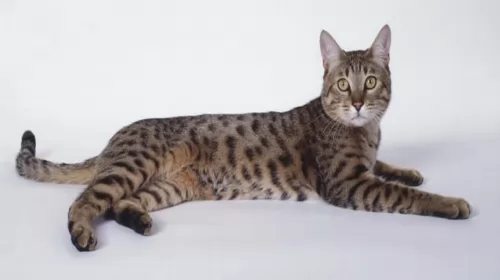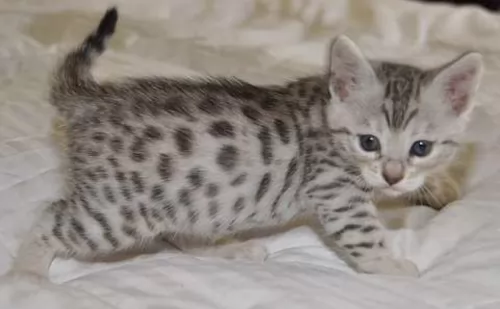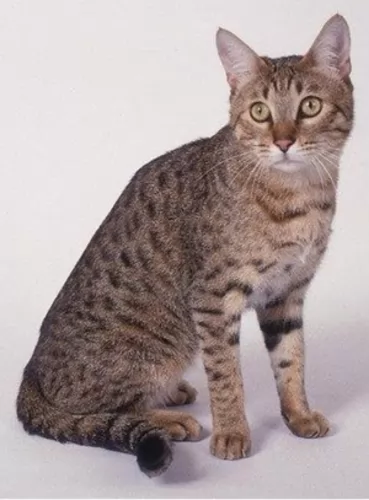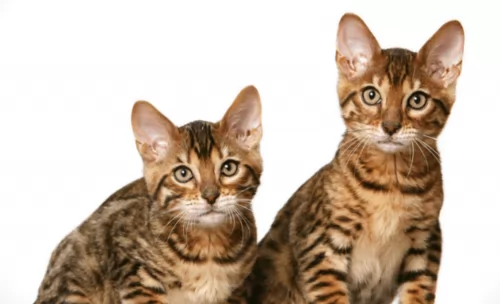 Petzlover
Petzlover California Spangled Cat is originated from United States but Turkish Van is originated from Turkey. Both California Spangled Cat and Turkish Van are of same weight. Both California Spangled Cat and Turkish Van has same life span. Both California Spangled Cat and Turkish Van has same litter size. California Spangled Cat requires Moderate Maintenance. But Turkish Van requires Low Maintenance
California Spangled Cat is originated from United States but Turkish Van is originated from Turkey. Both California Spangled Cat and Turkish Van are of same weight. Both California Spangled Cat and Turkish Van has same life span. Both California Spangled Cat and Turkish Van has same litter size. California Spangled Cat requires Moderate Maintenance. But Turkish Van requires Low Maintenance
 People seem to want a cat that resembles some of the wild cats we have, and the California Spangled is a domestic cat that has been bred to resemble spotted wild cats.
People seem to want a cat that resembles some of the wild cats we have, and the California Spangled is a domestic cat that has been bred to resemble spotted wild cats.
In fact, it was during the 1970s, that Paul Casey, an American scientist, returned from Tanzania to create a cat breed that resembled a wild cat such as a leopard.
There are many breeds that make up the California Spangled cat and these are the Abyssinian, British Shorthair, Siamese as well as some stray cats. Today, the breed has all but disappeared and there are only a few of the cats left.
 Hailing from Turkey, the Turkish Van was brought to the UK in 1955 by 2 British women, Laura Lushington and Sonia Halliday.
Hailing from Turkey, the Turkish Van was brought to the UK in 1955 by 2 British women, Laura Lushington and Sonia Halliday.
These cats were used as the foundation stock of the breed. They were brought to the United States in 1982 and accepted into championship with the Cat Fanciers’ Association in 1994.
They are a very rare breed and no other breed is allowed to be mixed into the cat's breeding schedule. All registered Turkish Van cats can have their ancestry traced back to the imported cats of Laura Lushington.
 The California Spangled cat is lean with a long muscular body and long legs. Its long body makes it look like it is on the prowl like a leopard.
The California Spangled cat is lean with a long muscular body and long legs. Its long body makes it look like it is on the prowl like a leopard.
Its coat, similar to that of a leopard, can be a mix of colors such as black, tan, silver, red and white with a mix of different shaped spots. The coat is fairly short and doesn’t require too much grooming. However, a brush will be like a bonding session for you and your cat and it will keep his coat shiny and free of loose hairs and dust.
The cat has almond-shaped eyes that are amber to copper-colored.
This cat is independent but it still wants to get a lot of attention from his owners. They’re affectionate, social and devoted to their human family. They are known for their intelligence and high energy levels, enjoying games that involve lots of action and participation.
Being an active cat, it needs a lot of space to roam and to play. Because he is smart, buy him interesting toys, a scratching post, and climbing equipment.
 This is a medium to large-sized cat weighing roughly 3 to 8kg. It’s a semi-long-haired domestic cat breed that was actually developed in the United Kingdom with a selection of cats from Turkey.
This is a medium to large-sized cat weighing roughly 3 to 8kg. It’s a semi-long-haired domestic cat breed that was actually developed in the United Kingdom with a selection of cats from Turkey.
The breed is distinguished by the Van pattern where the color is restricted to the head and tail. So the cat is white with color on the head and the tail. The Turkish Van has no undercoat and the cat has a sleek appearance.
The cat is quite long and its back legs are slightly longer than its front legs. The paws are large and they are strong jumpers.
These cats are playful, active, and independent and they are also excellent hunters. They are affectionate and form strong bonds with their human families.
They get on well with kids as well as with other pets. Energetic and agile, they love to leap up onto high places. For a cat, they also have this fascination with water and may well follow their human into a swimming pool or lake.
 These active but calm cats are very sociable, liking to talk to only when needed and then the meow of the cat is soft.
These active but calm cats are very sociable, liking to talk to only when needed and then the meow of the cat is soft.
While this cat would prefer being the only cat in the family, they are quite adaptable in the right environment and will adapt to a home where there are other pets.
These are cats that enjoy being the only cat in the house, but they are prepared to adapt to a life shared wth other cats or dogs.
They love playing and will respond well to children who have been taught how to be kind to animals.
They’re pricey cats these but they can certainly provide you with 15 years of great companionship.
 Lively, social, and intelligent, the Turkish Van is going to make you a wonderful pet and companion.
Lively, social, and intelligent, the Turkish Van is going to make you a wonderful pet and companion.
He is an active cat and will require you to play with him and provide some form of exercise for him.
He likes to leap up onto perches so getting him a climbing tree will serve him well as he is a cat that loves perching on high up places.
These cats are also low maintenance which simply adds to them being such perfect pets for single people, couples, families and seniors, just so long as he is provided with lots of love and care.
 Your Turkish Van counts on you to ensure his health and wellbeing. This will ensure he lives a long and healthy life.
Your Turkish Van counts on you to ensure his health and wellbeing. This will ensure he lives a long and healthy life.
Obesity is a major disease that contributes to many illnesses in cats. Excess weight is one of the factors for the development of arthritis and diabetes as well as some life-threatening diseases.
All kinds of parasites can invade your Turkish Van’s body. . Many types of parasites can be detected with a fecal exam, so a trip to your vet may be necessary.
 When it comes to feeding these cats, you’ll find that the California Spangled Cat is highly energetic and therefore his food needs to be of the very best high protein that there is.
When it comes to feeding these cats, you’ll find that the California Spangled Cat is highly energetic and therefore his food needs to be of the very best high protein that there is.
The cat requires high-quality food and food that is adapted to his growth and energy levels. If your California Spangled Cat had to hunt for his own food it would be mice and birds - protein.
In your home, he’ll need cat food high in protein. A diet deficient in protein can lead to all kinds of health issues. The reason for this is the protein has amino acids and this plays many essential roles in the body, strengthening the immune system.
Fortunately, in our busy world, commercially manufactured cat foods from top brands are nutritionally complete and balanced, and they’re high-protein cat foods. Proteins are imperative for the functioning of all body parts, and nursing queens for instance may well need more protein to get the kittens off to a good start.
Your California Spangled cat isn’t a huge shedder so a regular brushing once a week of the short coat will get rid of dust and loose hairs.
They’re playful cats these so provide them with games and toys that can help with using up some of this energy.
 One of the most important things with a cat is diet. The cat is a carnivore. Watch his diet, and make sure he gets plenty of meaty food.
One of the most important things with a cat is diet. The cat is a carnivore. Watch his diet, and make sure he gets plenty of meaty food.
Check with your vet if you aren’t sure how to feed your cat. There must always be a constant supply of fresh, cool water available and both food and water bowls must be washed regularly.
Regularly brush your cat’s coat gently and at the same time check the body over for any unusual lumps. If you discover a new lump, get your cat to the vet.
Be sure to schedule in your cat’s vaccinations as without these your cat can die from some of the more dangerous ones.
Another wise move, if at all possible, is to sign up for pet health insurance as then you won’t dread it financially when your vet requests medical tests be done on your cat.
There are simple things you can do to ensure the longevity of your beloved cat. Good food, exercise, fresh water, and plenty of love and attention.
Turkish Vans can have problems with their teeth. Teeth brushing can be massively traumatic and uncomfortable for your pet, but the best diet and vet care will ensure healthy teeth.
Cats are meticulous about hygiene so ensure the litter box is kept clean. Remove the cat’s feces every single day.